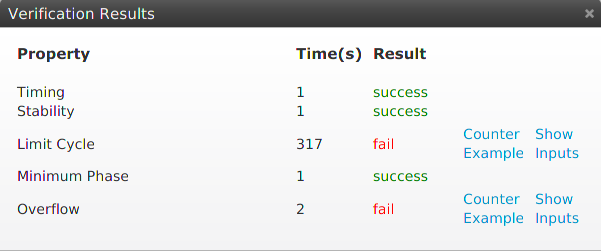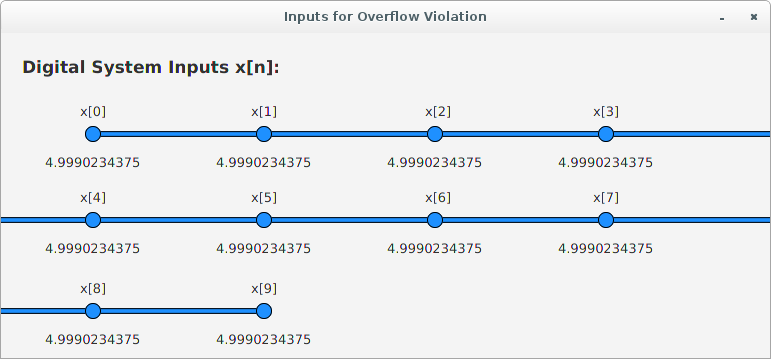–
Download the lastest version of DSVerifier at download page.
A video demonstration is available at: [Demonstration]
The source code is available at: https://github.com/ssvlab/dsverifier
Command Line Version
1) Generate manually a .c file with system specification.
For Digital-Systems standalone verification
#include <dsverifier.h>
digital_system ds = {
.a = { 1.0, -0.9 }, /* digital system denominator coefficients */
.a_size = 2, /* number of coefficients in denominator */
.b = { 1.561, -1.485 }, /* digital system numerator coefficients */
.b_size = 2 /* number of coefficients in numerator */
};
implementation impl = {
.int_bits = 3, /* number of bits in integer part of the fixed-point representation */
.frac_bits = 8, /* number of bits in precision part of the fixed-point representation */
.delta = 0.25, /* delta value used for delta form (if any) */
.max = 1.0, /* maximum value used in the digital system input */
.min = -1.0, /* minimum value used in the digital system input */
};
DSVerifier must be invoked using the following parameters:
./dsverifier example.c --realization DFI --property OVERFLOW --x-size 10 --bmc ESBMC --solver z3
For Digital-Systems in Closed-loop considering uncertainty
#include <dsverifier.h>
digital_system plant = {
.b = { 0.5486931, -0.886738 }, /* sampled plant numerator coefficients */
.b_uncertainty = { 0, 0 }, /* uncertainty numerator coefficients */
.b_size = 2, /* number of coefficients in numerator */
.a = { 1.0, -3.324812, 1.648721 }, /* sampled plant denominator coefficients */
.a_uncertainty = { 0, 0, 0 }, /* uncertainty numerator coefficients */
.a_size = 3 /* number of coefficients in denominator */
};
digital_system controller = {
.b = { -18.791301, 11.383944 }, /* digital control numerator coefficients */
.b_size = 2, /* number of coefficients in numerator */
.a = { 1.0, 3.635450 }, /* digital control denominator coefficients */
.a_size = 2 /* number of coefficients in denominator */
};
implementation impl = {
.int_bits = 3, /* integer part of the fxp representation (for controller) */
.frac_bits = 8, /* precision part of the fxp representation (for controller) */
};
DSVerifier must be invoked using the following parameters:
./dsverifier example2.c --property STABILITY_CLOSED_LOOP --connection-mode SERIES --bmc ESBMC --solver z3
2) Inspect the verification result:
VERIFICATION SUCCESSFUL ~ There is no violation of the property (i.e., the digital system specification meets its implementation)
VERIFICATION FAILED ~ The property is violated (i.e., DSVerifier finds a violation and produces a counterexample to refute the property)
Graphical User Interface (GUI)
DSVerifier GUI was developed in order to facilitate the digital-system verification. The GUI permit the parallel execution of verification tasks, which has the potential to decrease the total verification time spent by DSVerifier
The user can receive a graphical report for the properties verification.
The DSVerifier GUI extracts from the counterexample the input values used for overflow violation.
For DSVerifier GUI usage, it is necessary to have at least Java RunTime Environment Version 8.0 Update 40 (jre1.8.0 40) 3 , due to JavaFX components.


